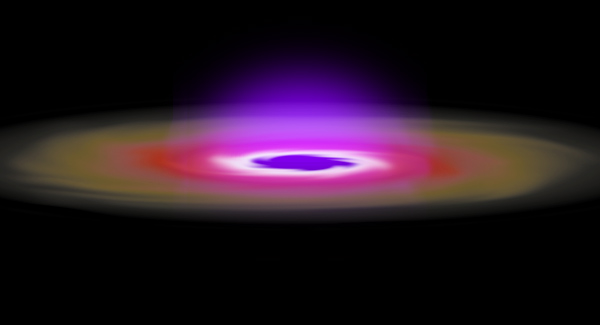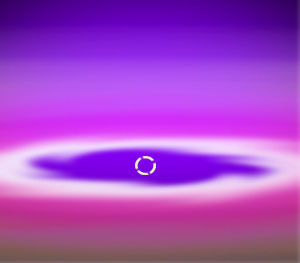Hot and very hot gas around black holes |
|
Research at the Max-Planck-Institute for Astrophysics elucidates how the X-rays from black holes are produced.

|
| Figure 1: Artist's impression of an accretion disk around a black hole, according to the new theory. The disk (brown and red) is opaque and relatively cool at temperatures up to 1 million degrees. Closer to the hole at the center is a region consisting of a very hot, transparent gas (more than 100 billion degrees, shown as the blue haze in the picture). In the white region the disk lights up due to the interaction with the hot gas surrounding it. In the theory this region plays a central role, and produces most of the observed X-rays. |
There are probably billions of black holes inhabiting our galaxy, but being black they are hard to discover. They betray their presence spectacularly, however, when they have a companion star orbiting around it which feeds gas onto it. In this case they become bright X-ray stars: the enormous gravitational forces near the hole heat the infalling gas to such temperatures that it emits X-rays.
But the observations of these X-rays pose some serious puzzles. Theory predicts that the gas flows to the hole in the form of an opaque, luminous disk, a so-called accretion disk (see figure 1), and its temperature is predicted to reach up to 10 million degrees. Actual observations of the X-rays show that in most cases this picture is not correct: the observed radiation is characteristic of gas at 1 billion degrees, not millions, and the radiating gas is probably transparent rather than opaque. It is as if the inner region of the accretion disk is missing and replaced by a tenuous very hot plasma.
The new theory developed at Max-Planck-Institute for Astrophysics now shows why this is so. It describes how the inner parts of the cool (1 million degree) disk transform to a very hot, 100 billion degree plasma. This plasma, heated by the gravitational forces near the black hole, is in contact with the inner edge of the disk (white area in the figure 1), and heats it to X-ray emitting temperatures. Most of the observed X-rays come from this 1 billion degree hot interaction region. The crucial part of theory predicts that this interaction region should `evaporate'. The evaporating gas becomes part of the very hot plasma (blue in figure 1), which is eventually swallowed by the black hole (see also the sketch in figure 2).

|
| Figure 2: Sketch of the transition from the cool accretion disk to a hot `2-temperature plasma' (also called 'ion supported accretion flow' or ISAF). Where the ISAF overlaps with the cool disk (inset), its energetic ions heat the disk, producing hard X-rays. This region also feeds mass into the ISAF. |
The main attraction of the theory developed is that it makes use of only the well know properties of hot ionized gas, in particular the way in which the electrons and protons exchange energy by electric forces in a so-called `2-temperature plasma'. It is a relatively straightforward consequence of these properties, but one that had so far been overlooked.

|
| Figure 3: Where is the black hole in figure 1? You can't see, it, it's black. Its location is indicated here by a broken white line, at the location of the so-called `horizon': the last surface near the hole from which any radiation can reach us. |
Henk Spruit, Bernhard Deufel, Kees Dullemond
Further information:
| MPA-Home |